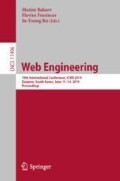Abstract
Words changing their meanings over time reflects various shifts in socio-cultural attitudes and conceptual structures. Understanding semantic change of words over time is important in order to study models of language and cultural evolution. Word embeddings methods such as PPMI, SVD and word2vec have been evaluated in recent years. These kinds of representation methods, sometimes referring as semantic maps of words, are able to facilitate the whole process of language processing. Chinese language is no exception. The development of technology gradually influences people’s communication and the language they are using. In the paper, a huge amount of data (300 GB) is provided by Sogou, a Chinese web search engine provider. After pre-processing, the Chinese language corpus is obtained. Three different word representation methods are extended to including temporal information. They are trained and tested based on the above dataset. A thorough analysis (both qualitative and quantitative analysis) is conducted with different thresholds to capture different semantic accuracy and alignment quality of the shifted words. A comparison between three methods is provided and possible reasons behind experiment results are discussed.
Access this chapter
Tax calculation will be finalised at checkout
Purchases are for personal use only
References
Bengio, Y., Ducharme, R., Vincent, P., Jauvin, C.: A neural probabilistic language model. J. Mach. Learn. Res. 3, 1137–1155 (2003)
Bullinaria, J.A., Levy, J.P.: Extracting semantic representations from word co-occurrence statistics: a computational study. Behav. Res. Methods 39(3), 510–526 (2007)
Garg, N., Schiebinger, L., Jurafsky, D., Zou, J.: Word embeddings quantify 100 years of gender and ethnic stereotypes. Proc. Nat. Acad. Sci. 115(16), E3635–E3644 (2018)
Grayson, S., Mulvany, M., Wade, K., Meaney, G., Greene, D.: Exploring the role of gender in 19th century fiction through the lens of word embeddings. In: Gracia, J., Bond, F., McCrae, J.P., Buitelaar, P., Chiarcos, C., Hellmann, S. (eds.) LDK 2017. LNCS (LNAI), vol. 10318, pp. 358–364. Springer, Cham (2017). https://doi.org/10.1007/978-3-319-59888-8_30
Hamilton, W.L., Leskovec, J., Jurafsky, D.: Cultural shift or linguistic drift? Comparing two computational measures of semantic change. In: Proceedings of the Conference on Empirical Methods in Natural Language Processing, vol. 2016, p. 2116. NIH Public Access (2016)
Hamilton, W.L., Leskovec, J., Jurafsky, D.: Diachronic word embeddings reveal statistical laws of semantic change. arXiv preprint arXiv:1605.09096 (2016)
Hellrich, J., Hahn, U.: Bad company—neighborhoods in neural embedding spaces considered harmful. In: Proceedings of COLING 2016, the 26th International Conference on Computational Linguistics: Technical Papers, pp. 2785–2796 (2016)
Jatowt, A., Duh, K.: A framework for analyzing semantic change of words across time. In: IEEE/ACM Joint Conference on Digital Libraries (JCDL), pp. 229–238. IEEE (2014)
Kulkarni, V., Al-Rfou, R., Perozzi, B., Skiena, S.: Statistically significant detection of linguistic change. In: Proceedings of the 24th International Conference on World Wide Web, pp. 625–635. International World Wide Web Conferences Steering Committee (2015)
Levy, O., Goldberg, Y., Dagan, I.: Improving distributional similarity with lessons learned from word embeddings. Trans. Assoc. Computat. Linguist. 3, 211–225 (2015)
Liu, Y., Chen, F., Kong, W., Yu, H., Zhang, M., Ma, S., Ru, L.: Identifying web spam with the wisdom of the crowds. ACM Trans. Web (TWEB) 6(1), 2 (2012)
Mikolov, T., Chen, K., Corrado, G., Dean, J.: Efficient estimation of word representations in vector space. arXiv preprint arXiv:1301.3781 (2013)
Mikolov, T., Yih, W.t., Zweig, G.: Linguistic regularities in continuous space word representations. In: Proceedings of the 2013 Conference of the North American Chapter of the Association for Computational Linguistics: Human Language Technologies, pp. 746–751 (2013)
Turney, P.D., Pantel, P.: From frequency to meaning: vector space models of semantics. J. Artif. Intell. Res. 37, 141–188 (2010)
Xu, Y., Kemp, C.: A computational evaluation of two laws of semantic change. In: CogSci (2015)
Yan, E., Zhu, Y.: Tracking word semantic change in biomedical literature. Int. J. Med. Informatics 109, 76–86 (2018)
Acknowledgement
This work was supported by National Undergraduate Training Program for Innovation and Entrepreneurship (No. 201810635003), National Natural Science Foundation of China (No. 61877051) and CSTC funding (No. cstc2017zdcy-zdyf0366).
Author information
Authors and Affiliations
Corresponding author
Editor information
Editors and Affiliations
Rights and permissions
Copyright information
© 2019 Springer Nature Switzerland AG
About this paper
Cite this paper
Xu, X., Cao, Y., Li, L. (2019). Exploring Semantic Change of Chinese Word Using Crawled Web Data. In: Bakaev, M., Frasincar, F., Ko, IY. (eds) Web Engineering. ICWE 2019. Lecture Notes in Computer Science(), vol 11496. Springer, Cham. https://doi.org/10.1007/978-3-030-19274-7_7
Download citation
DOI: https://doi.org/10.1007/978-3-030-19274-7_7
Published:
Publisher Name: Springer, Cham
Print ISBN: 978-3-030-19273-0
Online ISBN: 978-3-030-19274-7
eBook Packages: Computer ScienceComputer Science (R0)

